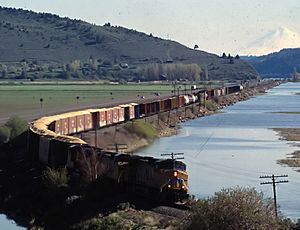Algoma, Oregon facts for kids
Quick facts for kids
Algoma, Oregon
|
|
|---|---|

Train passing by Algoma
|
|
| Country | United States |
| State | Oregon |
| County | Klamath |
| Elevation | 4,150 ft (1,260 m) |
| Time zone | UTC-8 (Pacific) |
| • Summer (DST) | UTC-7 (Pacific) |
| ZIP code |
97601
|
| Area codes | 458 and 541 |
Algoma is a small, unincorporated community in Klamath County, Oregon, United States. It is located on the east shore of Upper Klamath Lake. This community is about 8 miles (13 km) north of the city of Klamath Falls on U.S. Route 97. Algoma got its name from the Algoma Lumber Company.
How Algoma Started
In 1909, a man named R. H. Hovey bought a large area of timberland. This land was on the east side of Upper Klamath Lake in Klamath County, Oregon. This purchase was the beginning of the Algoma Lumber Company.
In 1912, Hovey built a big sawmill. This mill could process 100,000 board-feet of lumber in one work shift. Since the mill ran two shifts every day, it could produce 200,000 board-feet of lumber daily. The company grew very quickly. By the end of its first year, the mill and its logging work employed about 200 people. To house these workers, the company created the Algoma townsite.
The Algoma post office opened in 1912. The town of Algoma had about 400 people in 1919. Its population grew to 600 by 1931. In 1943, the post office closed down. Today, Algoma is not counted as a specific census area. This means there is no current population information for the community.
What Was a Company Town?
The Algoma townsite was built about 8 miles (13 km) north of Klamath Falls. It was located on Rattlesnake Point, right by Upper Klamath Lake. The town was created in 1912 to support the workers of the Algoma Lumber Company.
The Algoma lumber mill was built on a 26-acre (0.11 km²) site. This area was in Plum Valley, near Algoma Marsh. Algoma Marsh was a large 1,300-acre (5.3 km²) meadowland. A Union Pacific railroad track separated this area from Upper Klamath Lake.
The Algoma Lumber Company logged trees all around Upper Klamath Lake. The company used a special diesel-powered tugboat to pull rafts of logs to the mill. The mill's log pond was connected to the lake. A 20-foot (6.1 m) culvert ran under the railroad track to connect them. Because this channel was shallow, the company needed Upper Klamath Lake to stay at a high water level. The tugboat used by the company was retired in 1943. Today, you can see it on display at the logging museum. This museum is at Collier Memorial State Park, about 30 miles (48 km) north of Klamath Falls.



